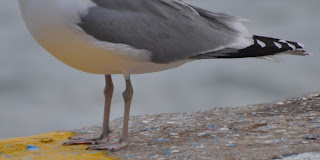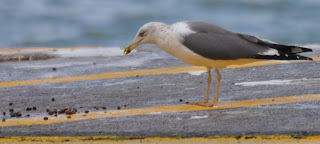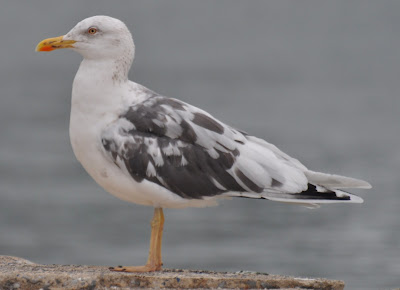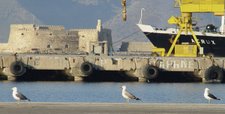Diogenes: What about his species status?
Διογένης: Αναζητώντας το είδος του
Diogenes is not just a Gull, is the star bird of Herakleion Harbour, It winters the last five years. First noticed on late December 2011 - was a bird easily spotted due to its leucistic appearance. I named him "Stephan" due to name day but later we change to Diogenes as a friend, George, decided and it was well adapted.
Ο Διογένης δεν απλώς ένας ακόμη γλάρος, είναι ο σταρ του λιμανιού στο Ηράκλειο όπου ξεχειμωνιάζει τα πέντε τελευταία χρόνια. Βρέθηκε πρώτη φορά στις 27/12/2011 - εντοπιζόμενος εύκολα λόγω του χαρακτηριστικού του λευκισμού και του έδωσα το προσωρινό χαϊδευτικό όνομα "Στέφανος" που γιόρταζε την ημέρα αυτή, αλλά αργότερα άλλαξε σε Διογένης που του ταίριαξε τέλεια, με νονό τον φίλο Γιώργο.
December 27, 2011
I found out that Diogenes used to keep certain spots of harbour to rest in day time, and was aggressive to all others Larus individuals. He did not follow the flocks of gulls to their social roost. he stayed that season up to March 2012. It is not only leucistic but also partly melanistic with unusual for an adult large white gull black spots in tail and wings,
Γρήγορα κατάλαβα ότι ο γλάρος αυτός χρησιμοποιούσε συγκεκριμένα σημεία του λιμανιού για ξεκούραση και τα υπερασπιζόταν από τους υπόλοιπους γλάρους, που δεν τους ακολουθούσε στις κούρνιες τους. Παρέμεινε στο λιμάνι τουλάχιστον ως το Μάρτη του 2012. Στην πραγματικότητα δεν είναι ακριβώς λευκοστικός αφού είναι επίσης και μελανιστικός σε κάποια σημεία όπως στην ουρά!
February 21, 2013
He came back on October 2012 and I was surprised as was showed more white in mantle and covers tahn previous year. Stayed as late as February 2013.
Επανεμφανίστηκε τον Οκτώβριο του 2012 και με έκπληξη παρατήρησα ότι ο μανδύας του και οι φτερούγες του είχαν ακόμη περισσότερο λευκό από τον προηγούμενο χρόνο. Παρέμεινε τουλάχιστον ως τον Φεβρουάριο του 2013 (πάνω).
February 14, 2014
The amount of white was even more next year (November 2013 to Apr 2014).
Το άσπρισμα συνεχίστηκε τον επόμενο χρόνο (Νοέμβριος 2013 ως Απρίλιο 2014).
January 7, 2015
The forth year of finding Diogenes was the longest, seen from September 2014 to May 2015. It was much whiter!
Τον επόμενο χρόνο ο Διογένης έμεινε πολύ περισσότερο χρόνο, Σεπτέμβριο 2014 ως τον Μάη του 2015, ακόμα περισσότερο ασπρισμένος.

December 11, 2015
This year Diogenis was found again in late October 2015. Now most of mantle is white and the black on wing primaries and tail almost gone!
Αυτή τη χρονιά ο Διογένης βρέθηκε από τα τέλη Οκτώβρη 2015. Πλέον ο μανδύας του είναι σχeδόν κάτασπρος και τα μαύρα στα πρωτεύοντα φτερά του και ο μελανισμός στην ουρά σαν να εξαφανίστηκαν!
Lets see Diogenes other side.
Βλέπουμε παρακάτω αντίστοιχα την άλλη πλευρά του σώματος.
December 27, 2011
So, what about species status?
Λοιπόν, τι είδος είναι αυτό το άτομο;
November 15, 2012
If we take as more characteristic the mantle colouring the Diogenes belong to fuscus species complex.
Αν μείνουμε στο γκρίζο χρώμα που κυριαρχεί στο μανδύα θα πρέπει να τον κατατάξουμε στην ομάδα των Μελανόγλαρων (fuscus group)
March 7, 2014
Diogenes is large, male sized, with heavy bill and longish legs. The mantle colour and size eliminates Baltic Gull, and legs give the impression to be most possible a Heuglin's Gull than a western LBBG..
Ο Διογένης είναι μεγάλος, παραπέμποντας σε αρσενικό άτομο, με ισχυρό ράμφος και μακριά πόδια. Πέρα από το μέγεθος και ο μανδύας δεν είναι αρκετά σκούρος για Μελανόγλαρο της Βαλτικής όμως ειδικά το χρώμα και το μήκος των ποδιών δείχνουν περισσότερο για Ρωσικό Μελανόγλαρο παρά για δυτικό Μελανόγλαρο graellsii / intermedius
November 14, 2014
There are still some doubts about its species status, but its voice heard few times and late primary moult make me to believe that Larus (fuscus) heuglini is the one.
Αν και υπάρχουν λογικές αμφιβολίες η βοήθεια από τους ήχους που βγάζει κατά καιρούς και η καθυστέρηση στην παραγωγή νέων πρωτευόντων μέσα στο χειμώνα πείθουν για τη βόρεια (αρκτική) καταγωγή του σαν Larus (fuscus) heuglini.
December 18, 2015
Next three pics: late moult and changes to be whiter over the years.
Στις τρεις επόμενες φωτογραφίες διακρίνονται οι μεγάλες αλλαγές στη μορφή του πτερώματος τα 4 αυτά χρόνια και η καθυστέρηση στην αλλαγή των φτερών, χαρακτηριστικό των βόρειων ειδών γλάρων,
November 15, 2012
December 11, 2015
December 11, 2015
Legs are not so yellowish unlike western LBBG,
Ο χρωματισμός των ποδιών, όχι κιτρινωπά όπως οι δυτικοί μελανόγλαροι, θεωρητικά τουλάχιστον αυτά δεν επηρεάζονται από τον παράγοντα που προκαλεί το λευκισμό.
December 11, 2015
Bill quite heavy with gonys angle. Eye not pale, nice orange orbital ring
Αρκετά βαρύ ράμφος με το "γόνατο" στην κάτω σιαγόνα και μάλλον σκούρο μάτι με πορτοκαλί περιφθάλμιο.
December 11, 2015
Questions:
1. Is normal to change more white over years?
2. Why he prefers to be alone on harbour? s it a result of his specificity/anomaly?
3. Where does he spend his summers? What about breeding?
4. Is the identification as a male Heuglin's Gull correct?
Ερώτηση 1η: Είναι λογικό να ασπρίζει όσο περνούν τα χρόνια;
Ερώτηση 2η: Γιατί επιλέγει τη μοναξιά στο λιμάνι; λόγω ιδιαιτερότητας;
Ερώτηση 3η: Που πηγαίνει τα καλοκαίρια; που αναπαράγεται;
Ερώτηση 4η: Είναι ορθός ο προσδιορισμός ως αρσενικός Μελανόγλαρος της Ρωσίας (Σιβηρίας);
December 22, 2015.




















































